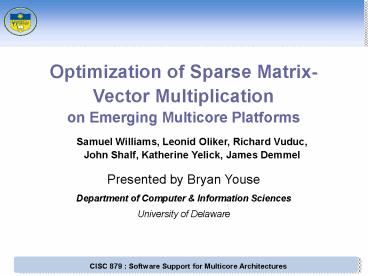Optimization of Sparse MatrixVector Multiplication PowerPoint PPT Presentation
1 / 16
Title: Optimization of Sparse MatrixVector Multiplication
1
Optimization of Sparse Matrix-Vector
Multiplication on Emerging Multicore Platforms
Samuel Williams, Leonid Oliker, Richard Vuduc,
John Shalf, Katherine Yelick, James Demmel
Presented by Bryan Youse Department of Computer
Information Sciences University of Delaware
2
Sparsity
- Dense Matrix "common" matrix
- Sparse Matrix few non-zero entries
- Sparsity typically expressed as the number of
non-zero entries per row
3
Why care?
- SpMV one of the most heavily used kernels in
scientific computing - Other applications
- Economic modeling
- Information retrieval
- Network theory
- Historically (currently!) terrible performance
- Current algorithms run at 10 or less of machine
peak performance on a single-core, cache based
processor - Dense matrix kernels gtgtgt similar Sparse kernels
4
What's the hold up?
- Problems with sparse kernels
- data structure woes needs to both
- exploit properties of the sparse matrix
- fit machine architecture well
- run-time information needed
- this is the major disadvantage to the dense
kernels
5
Data Structure
- Compressed Sparse Row (CSR) is the standard
- Many optimization tricks can be used to exploit
this format
6
SpMV Optimizations
- 3 categories of optimizations
- Low-level code optimizations
- Data structure optimizations
- this includes the requisite code changes
- Parallelization optimizations
- Note that the first two largely affect single
core performance - Goal As much auto-tuning as possible
7
Optimizations Blocking
- Thread Blocking
- Thread-level parallelism split matrix up (by
rows, cols, or blocks)? - Cache Blocking
- Problem Very large matrices cannot fit the
entire source or answer vectors in cache - Solution Split matrix up into cache-sized tiles
(1K x 1K is common)
8
Optimizations Blocking (2)?
- TLB Blocking
- TLB misses can vary by an order of magnitude
depending on the blocking strategy - Register Blocking
- Group adjacent non-zeros into rectangular tiles
- Key point to take from blocking SpMV is a
memory-bound application reducing memory
footprint is more important than anything else
9
More Optimizations
- Index Size Selection
- 16b integers to reduce memory traffic
- SIMDization
- Software Prefetching
- Get the data we know we'll need soon in cache
- Architecture Specific Kernels
- through auto-tuning
10
Last Optimization, I Swear
- Loop Optimizations, of course!
- CSR format enables the core kernel loop to go
from
Old Busted Nested loop with two loop variables
New Hotness Remove inner loop variable
11
What about the ''emerging multicore platforms''
part?
- Several leading multicore platforms were tested
12
Testing Suite
- Actually, the dense matrix provides the
performance upper bound - SpMV is limited by memory throughput
- Dense case supports arbitrary register blocks
(no added zeros)? - Loops are long running -gt more CPU time vs.
Memory fetch time
13
Promising Initial Results
- Remember, outside of this project, we typically
expect only 10 of peak performance
14
More Results
15
More Results
16
- Cell's SpMV times are dramatically faster
- All architectures showed good results
- motivating the need for these optimizations!

